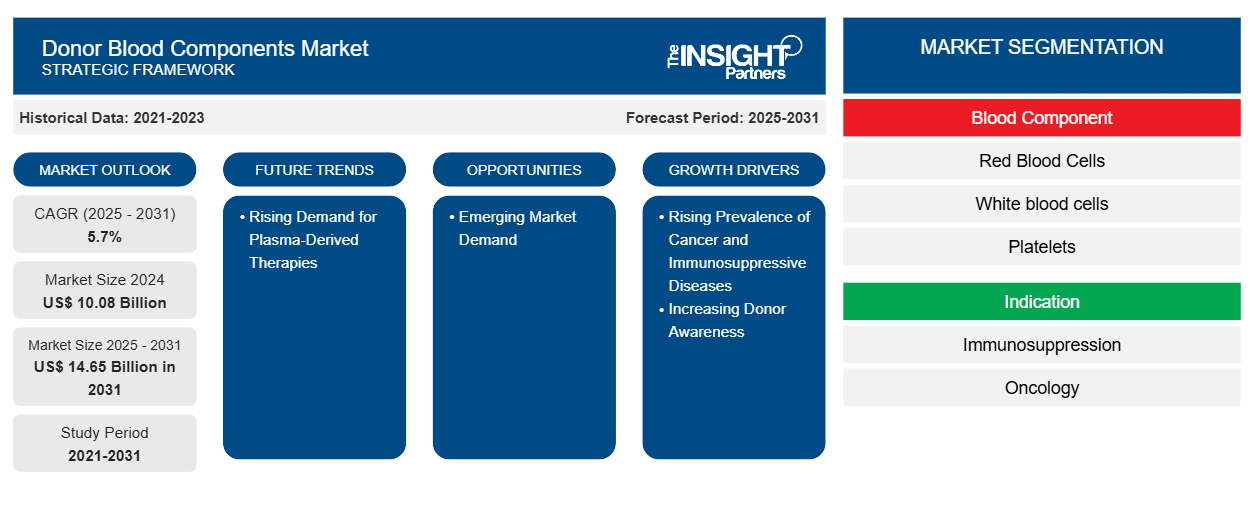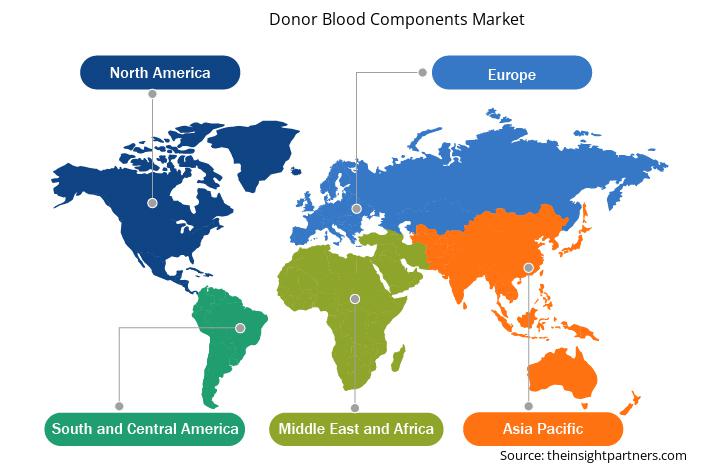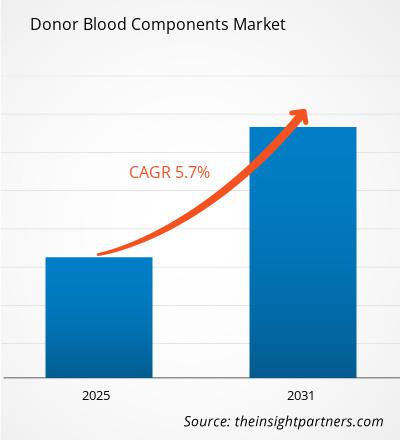预计到2031年,捐献血液成分市场规模将从2024年的100.8亿美元增至146.4亿美元。预计2025年至2031年期间,该市场的复合年增长率将达到5.7%。预测期内,血浆衍生疗法的需求不断增长,可能会带来新的市场趋势。
捐献血液成分市场分析
捐献血液成分市场是医疗保健行业的重要细分市场之一,其驱动力在于外科手术、创伤、癌症治疗和慢性疾病期间对安全输血的需求日益增长。捐献血液成分包括红细胞 ( RBC )、血浆、血小板和冷沉淀。全球意识的提高、人口老龄化以及采集和储存技术的不断进步推动着捐献血液成分市场的增长。然而,某些地区自愿献血率低、监管问题和物流限制等问题依然存在。血液分离和病原体灭活系统等新技术正在提高产品安全性和效率。此外,政府和非政府组织为增加定期自愿献血而采取的举措正在扩大献血者群体。市场潜力巨大,尤其是在不断发展的医疗保健体系中。
捐献血液成分市场概况
由于癌症和免疫抑制疾病的发病率不断上升,以及捐献意识的不断增强,捐献血液成分市场正在迅速扩张。市场上的知名企业正致力于创新和合作,以提升产品的可及性和覆盖面。然而,自愿捐献的不稳定性阻碍了市场的增长。
您可以免费定制任何报告,包括本报告的部分内容、国家级分析、Excel 数据包,以及为初创企业和大学提供优惠和折扣
捐献血液成分市场:战略洞察

- 获取此报告的顶级关键市场趋势。此免费样品将包括数据分析,从市场趋势到估计和预测。
捐献血液成分市场驱动因素和机遇
癌症和免疫抑制疾病患病率上升推动市场增长
全球范围内,癌症和免疫抑制性疾病的发病率正在上升。由于化疗、放疗和骨髓移植的副作用,癌症患者经常需要输注红细胞和血小板,这些副作用会导致贫血和血小板减少。根据美国癌症协会的数据,2024年美国新增癌症病例约200万例,其中淋巴瘤患者约89,190例,骨髓瘤患者约35,780例,白血病患者约62,770例。大多数患者严重依赖输血来应对副作用并提高生活质量。
患有免疫抑制疾病(例如艾滋病毒/艾滋病)、自身免疫性疾病以及器官移植后接受免疫抑制治疗的患者需要血浆衍生产品(例如免疫球蛋白和凝血因子)来增强免疫功能并预防感染。2023年,联合国艾滋病毒/艾滋病联合规划署( UNAIDS)报告称,全球有超过3990万艾滋病毒感染者,其中许多人依靠血液成分生存。
根据GLOBOCAN 的估计,到 2040 年,全球癌症发病率预计将每年增加 2840 万例,这将大幅增加肿瘤治疗中心和医院对血液成分的需求。此外,老年人口的增长也推动了对安全可靠的血液供应的需求,老年人更容易患癌症和免疫抑制疾病。
日益严重的健康状况凸显了持续提供献血和高科技血液成分处理技术的迫切需求。医疗机构和血库正在不断提升自身能力,以满足这一需求。因此,癌症和免疫抑制性疾病的发病率不断上升,推动了捐献血液成分市场的增长。
新兴市场需求创造市场盈利机会
新兴经济体,尤其是东南亚、拉丁美洲和非洲部分地区的新兴经济体,为捐献血液成分市场提供了强劲的增长机遇。随着这些经济体医疗基础设施的不断发展,对献血设施的投资正成为一项战略要务。在阿根廷、巴西和墨西哥,自愿献血项目取得了显著进展:2023年,拉丁美洲共收到超过920万单位血液,比2020年增长15.5%,其中56.8%的献血来自移动募捐活动和线上宣传。这一增长体现了宣传活动和公私联盟对国家血液系统产生的协同作用。同样,例如在印度尼西亚,亚洲 农业等企业捐赠者发起了区域性献血周活动,从农村省份累计捐赠了数百单位血液。2024年6月,他们联系了414名献血者,并从三个省份募集了287单位血液,为库存补充和宣传做出了贡献。这些私营部门的合作增强了社区信任和捐赠者的参与度。
据世界卫生组织估计,发展中国家对血液制品的需求预计每年增长5%。为了满足这一需求,这些国家正致力于基础设施的现代化,例如印度尼西亚新建的血浆分离工厂,以及非洲增加的流动采血。血液分离设备、核酸检测和自动化处理等技术的运用正在增强血液制品的安全性和公众信任度。
医疗需求增长、自愿献血人数增加、数字化推广以及监管改革等因素的融合,为新兴市场在献血服务领域的增长奠定了基础。这些系统的发展不仅满足了日益增长的临床需求,也促进了全球献血成分市场的长期可持续发展。
捐献血液成分市场报告细分分析
有助于得出捐献血液成分市场分析的关键部分是血液成分、适应症、应用、年龄组和最终用户。
- 根据血液成分,捐献血液成分市场可细分为红细胞、白细胞、血小板、血浆及其他。红细胞在2024年占据了最大的市场份额。
- 根据适应症,捐献血液成分市场可分为免疫抑制和肿瘤治疗两大类。2024年,免疫抑制领域占据市场主导地位。
- 从应用角度来看,捐献血液成分市场细分为贫血管理、血小板减少症治疗、凝血病矫正、化疗期间的支持性护理、手术及其他领域。贫血管理领域在2024年占据了最大的市场份额。
- 按年龄段划分,捐献血液成分市场分为成人和儿童两类。2024年,成人群体占据市场主导地位。
- 根据最终用户,捐献血液成分市场可分为医院、肿瘤中心、移植中心、门诊手术中心和其他。2024年,医院市场占据主导地位。
捐献血液成分市场份额(按地区)分析
捐献血液成分市场报告的地理范围主要集中在五个地区:北美、亚太地区、欧洲、南美和中美以及中东和非洲。就收入而言,北美在 2024 年占据市场主导地位。预计在预测期内,它将继续在全球市场中占据主导地位。美国是世界上最大的捐献血液成分市场。根据美国癌症协会的数据,2022 年,该国诊断出约 190 万例新发癌症病例,导致约 61 万人死亡。癌症患者在化疗期间需要定期输血。化疗和放疗常常导致严重的血小板减少症和中性粒细胞减少症,需要输注血小板和血浆以防止危及生命的出血和感染。根据白血病和淋巴瘤协会的事实和统计概览,美国每 3 分钟就有一人被诊断出患有白血病、淋巴瘤或骨髓瘤。此外,约有 456,481 人患有白血病。白血病会影响骨髓,减少健康血细胞的产生并导致贫血,因此经常输注红细胞、血小板和血浆至关重要。
为了满足日益增长的血液成分需求,血库和组织(例如美国红十字会和血液与生物治疗促进协会)加强了捐献者招募和血液采集工作。根据美国红十字会的统计,每两秒钟,全国就有人需要血液或血小板来进行手术、癌症治疗、慢性病和创伤。全国每天需要约 29,000 单位红细胞、5,000 单位血小板和 6,500 单位血浆。据同一来源称,美国每年约有 680 万人献血。这些捐献总计每年在全国收集约 1360 万单位全血和红细胞。美国红十字会向捐献者提供全国约 40% 的血液和血细胞成分,美国每年输血约 1600 万份血液成分。
此外,器官移植需求的不断增长可能会推动血液成分的需求。根据器官获取和移植网络 (OPTN) 的数据,该国进行的移植手术数量从 2021 年的 41,000 例增加到 2024 年的 48,149 例。2024 年,全国平均每天进行 132 例移植手术。在移植手术期间,患者通常会经历大量失血,需要大量血液来维持稳定的血液循环并支持器官功能。接受者可能需要在手术前后输血,以控制贫血、促进康复,并对抗可能影响血细胞生成的免疫抑制疗法。
捐献血液成分市场区域洞察
Insight Partners 的分析师已详尽阐述了预测期内影响捐献血液成分市场的区域趋势和因素。本节还讨论了北美、欧洲、亚太地区、中东和非洲以及南美和中美洲的捐献血液成分市场细分和地域分布。

- 获取捐献血液成分市场的区域特定数据
捐献血液成分市场报告范围
| 报告属性 | 细节 |
|---|---|
| 2024年的市场规模 | 100.8亿美元 |
| 2031年的市场规模 | 146.5亿美元 |
| 全球复合年增长率(2025-2031) | 5.7% |
| 史料 | 2021-2023 |
| 预测期 | 2025-2031 |
| 涵盖的领域 | 按血液成分
|
| 覆盖地区和国家 | 北美
|
| 市场领导者和主要公司简介 |
|
捐献血液成分市场参与者密度:了解其对业务动态的影响
捐献血液成分市场正在快速增长,这得益于终端用户需求的不断增长,而这些需求的驱动因素包括消费者偏好的演变、技术进步以及对产品益处的认知度的提升。随着需求的增长,企业正在扩展产品线,不断创新以满足消费者需求,并抓住新兴趋势,从而进一步推动市场增长。
市场参与者密度是指特定市场或行业内企业或公司的分布情况。它表明特定市场空间内竞争对手(市场参与者)的数量相对于其规模或总市值而言。
在捐献血液成分市场运营的主要公司有:
- 罗斯威尔帕克综合癌症中心
- 米兰综合诊所
- 维塔兰特
- MD安德森癌症中心
- 约翰·霍普金斯医院
- 皇家马斯登
免责声明:以上列出的公司没有按照任何特定顺序排列。

- 获取捐献血液成分市场主要参与者概览
捐献血液成分市场新闻及最新发展
捐献血液成分市场评估是通过收集一手资料和二手资料后进行的定性和定量数据进行的,这些数据包括重要的企业出版物、协会数据和数据库。捐献血液成分市场的主要发展如下:
- 红十字会与武装部队血液项目建立合作伙伴关系,以加强军民血液供应。(来源:美国红十字会,《公司新闻》,2025年7月)
- 由于血液供应不足,英国国家医疗服务体系 (NHS) 需要 20 万名新的献血者。(来源:英国国家医疗服务体系血液和移植中心 (NHSBT),新闻稿,2024 年 XX 月)
捐献血液成分市场报告覆盖范围和交付成果
《捐献血液成分市场规模和预测(2021-2031)》报告对以下领域进行了详细的市场分析:
- 捐献血液成分市场规模及预测,涵盖全球、区域和国家层面的所有主要细分市场
- 捐献血液成分市场趋势以及市场动态,例如驱动因素、限制因素和关键机遇
- 详细的 PEST 和 SWOT 分析
- 捐献血液成分市场分析涵盖主要市场趋势、全球和区域框架、主要参与者、法规和最新市场发展
- 行业格局和竞争分析,涵盖市场集中度、热图分析、知名参与者以及捐献血液成分市场的最新发展
- 详细的公司简介
- 历史分析(2 年)、基准年、预测(7 年)及复合年增长率
- PEST和SWOT分析
- 市场规模、价值/数量 - 全球、区域、国家
- 行业和竞争格局
- Excel 数据集
近期报告
客户评价
购买理由
- 明智的决策
- 了解市场动态
- 竞争分析
- 客户洞察
- 市场预测
- 风险规避
- 战略规划
- 投资论证
- 识别新兴市场
- 优化营销策略
- 提升运营效率
- 顺应监管趋势




















 获取免费样品 - 捐献血液成分市场
获取免费样品 - 捐献血液成分市场